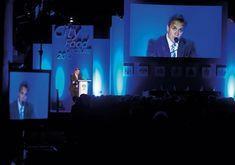
Justin King has presided over a period of sustained success at Sainsbury’s, overcoming some fairly major challenges to make the supermarket one of the largest and most respected in the country. Part of that success has undoubtedly come through fusing modern retailing with old-fashioned techniques, and at the City Food Lecture last week he endorsed the view that there were many ‘retro’ trends being seen in the current grocery market.
Throwbacks to the past included more people shopping on foot, smaller baskets at the weekend supplemented by top-up shopping, more home deliveries and a return to a more “personal” shopping experience with greater interaction between knowledgeable staff and customers, King said.
But he also stressed that this personal experience had branched out into myriad directions through the use of loyalty cards, smartphones and the internet.
Sainsbury’s saw online orders grow at 20 per cent last year, with a record 160,000 orders a week delivered over Christmas. However King did not predict a decline in physical stores, but instead a growth in ‘multi-channel’ shopping such as ‘click & collect’ and ‘virtual stores’ like those trialled in subway stations, where shoppers can scan products on posters into their virtual baskets.
King also played down fears over the death of the high street, claiming supermarkets were not to blame for the increase in vacancies and pointing out that grocers have long had a presence in town centres. “There is a risk of looking back through rose-tinted spectacles to an era that never really existed,” he said. “As long ago as 1939, chain stores and co-operative retail societies already controlled about half of the grocery market.” There were still many examples of successful high streets around the country, he added.
“Supermarkets have reflected society, and changes in society. Many shoppers do not have the time to potter between the butcher, baker and grocer. And those rose-tinted spectacles don’t always recall the often poor quality, poor choice, and poor value for money those ‘old’ high streets were able to offer.”
King said he agreed with much of what Mary Portas wrote in her recent report on the state of Britain’s high streets. “We need to recognise that the best high streets are a mix of retail and other activities,” he reasoned. “We need to recognise that the best high streets are easy to access, with clean, tidy and well-invested public areas. We need to be brave enough to re-shape the high street and allow empty shops to be converted for other uses such as residential where there is over-capacity. We need to ensure that our offer fully reflects the trends in changing consumer behaviour that I have outlined. And high streets need to learn from large successful retailers, and encourage their investment and participation in regeneration.”
King concluded by alluding to Sir Isaiah Berlin’s concept of foxes and hedgehogs. Foxes are cunning and adapt to their environment, while hedgehogs roll into a ball and wait for things to improve. The best businesses, he said, were foxes. -